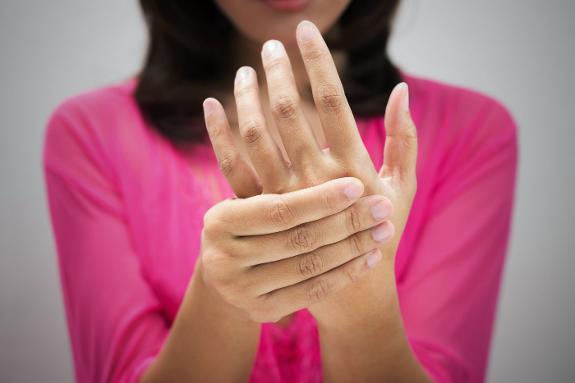

Secciones
Servicios
Destacamos

ROCÍO MENDOZA
Monday, 21 December 2020, 18:06
Three centuries ago, people began to talk about 'writer's cramp' for the first time. In 1864 the prestigious medical journal The Lancet was saying that people with this syndrome suffered constant pain between the thumb and index finger, accompanied by a certain rigidity of the hand when beginning to write.
It didn't only affect those for whom writing was a profession: cobblers, farmers who milked cows, musicians (pianists, harpists, guitarists), tailors and seamstresses also suffered from it. In other words, all those who spent hours using their hands for repetitive movements to carry out their work.
These problems still occur today but with a couple of essential differences: nowadays the injuries are caused by using keyboards, computer mice and touchscreens and, more relevantly, they affect not only professionals but a large part of the population. Even teenagers are now in need of treatment for unbearable pain in the thumbs, caused by too many hours using electronic devices.
The human hand is a true work of engineering which has reached its present form through the history of evolution. It is strong but delicate at the same time. It is made of 27 bones (14 phalanges, 8 carpals and 5 metacarpals) with tendons and flexor muscles between, so one would think it was prepared for just about anything. It grips with force, makes subtle movements and manipulates objects with great precision.
Against nature
The list of tasks our hand can carry out is endless: from using tools to waving. However, it does not appear to be designed for the posture we have to adopt to use technological devices, especially mobile phones and tablets. The latter go against the anatomic design of these appendages.
For example, the fact that these devices are portable means they can be used in different positions or places of work which are not suitable, such as a sofa, in a café, on public transport etc.
"That in itself produces different situations which can have an effect at the musculoskeletal level," says José Casaña, a doctor of physiotherapy from Valencia who is the general secretary of the General Council of the College of Physiotherapists of Spain.
What also happens is that the design of the hand-held devices means that the wrist and fingers do not rest upon a surface while they are being used.
"This can lead to muscular overload through forced postures which affect the area of the neck, shoulder, forearm and hand," he says.
With regard to the hand, he explains that the pain in the fingers occurs when these unsuitable postures are maintained for a prolonged period, and there is constant repetition of a movement, such as sending messages or scrolling down a screen without the forearm being supported on a surface.
"Repetitive actions normally generate an articular capsule pain because of inflammatory processes, while in the postures the pain that occurs is of muscular origin, produced by overload and accumulated tension," he explains.
Together with the bad posture, the lack of mobility and repetitive movements, the time spent using a device is one of the factors which can most influence the possible appearance of injuries.
Reduce the number of hours
The most common problems are 'rizarthrosis', or arthrosis of the thumb, De Quervain's tenosynovitis, (an inflammation of the tendon between the long adductor and the short extensor muscle of the thumb) and trigger finger (when it remains stuck in a bent position . Also, due to a compression of the median nerve through an inflammatory process, there is the famous carpal tunnel syndrome, the result of bad posture when using a computer and mouse. Finally, at times the cubital nerve of the elbow is affected, and this gives a feeling of numbness in several fingers, especially the annular and the little finger.
It might seem that we are all destined to suffer from such problems at some time, because we use these devices so much. However, changing some habits and doing certain exercises can help to avoid this.
The first preventive measure seems very obvious: reduce the number of hours spent using these devices. When this isn't possible, the College of Physiotherapists advises using hands-free systems whenever possible, using the voice assistant to write messages or, otherwise, send audio ones. If this isn't possible, they recommend supporting the arms on a flat surface when writing messages or long emails, and using both hands. The experts also say we should take 30-minute breaks every now and then.
Casaña ends his advice with something which should probably have come at the beginning: nobody should just put up with the pain and hope it will pass, because the injury could become chronic and even lead to other problems.
"By recommending exercises we can ensure that the structures involved are prepared and protected. When injuries occur and we need to do something, physiotherapy is essential and it produces very satisfactory results," he says.
Publicidad
Publicidad
Publicidad
Publicidad
Esta funcionalidad es exclusiva para registrados.
Reporta un error en esta noticia

Debido a un error no hemos podido dar de alta tu suscripción.
Por favor, ponte en contacto con Atención al Cliente.

¡Bienvenido a SURINENGLISH!

Tu suscripción con Google se ha realizado correctamente, pero ya tenías otra suscripción activa en SURINENGLISH.
Déjanos tus datos y nos pondremos en contacto contigo para analizar tu caso

¡Tu suscripción con Google se ha realizado correctamente!
La compra se ha asociado al siguiente email
Comentar es una ventaja exclusiva para registrados
¿Ya eres registrado?
Inicia sesiónNecesitas ser suscriptor para poder votar.